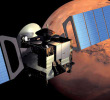Mars Express - PSA
Mars Express

Mars Express (MEX), so called because of the rapid and streamlined development, represents ESA's first visit to another planet in the Solar System. The spacecraft borrowed technology from the Mars 96 mission and from ESA's Rosetta mission to comet 67P/Churyumov-Gerasimenko. Mars Express is helping to answer fundamental questions about the geology, atmosphere, surface environment, history of water and potential for life on Mars. Mars Express was launched on the 2 June 2003 on a Soyuz-Fregat from the Baikonur Cosmodrome in Russia. The end of the nominal mission phase was the 20 November 2005, but it is still operating and data is still being harvested.
Mars Express Orbiter Instruments
ASPERA-3Analyser of Space Plasmas and EneRgetic Atoms
The scientific objective of the ASPERA-3 experiment is to study the solar wind-atmosphere interaction and characterise the plasma and neutral gas environment in near-Mars space through Energetic Neutral Atom (ENA) imaging and local charged particle measurements. |
HRSCHigh Resolution Stereo Camera
HRSC provides simultaneous high-resolution stereo, multicolour and multi-phase imaging of the Martian surface. An additional Super Resolution Channel provides frame images embedded in the basic HRSC swath at five times greater resolution. HRSC Press Releases (credit: DLR / FU Berlin / ESA) |
MARSISMars Advanced Radar for Subsurface and Ionosphere Sounding
MARSIS is a multi-frequency nadir-looking radar sounder and altimeter, using synthetic aperture techniques and a secondary receiving antenna to enhance reflections from the Martian subsurface and ionosphere. Note that the NASA PDS archive also has PDS4 dataset with higher level MARSIS data, whose development was funded via NASA's PDART program, which can be found at: https://pds-geosciences.wustl.edu/mex/urn-nasa-pds-mex_marsis_optim/ |
MRSMars Express orbiter Radio Science
The spacecraft Telemetry, Tracking and Command (TT and C) radio links between the Mars Express orbiter and the Earth are also used for radio science investigations. |
OMEGAObservatoire pour la Mineralogie, l'Eau, les Glaces et l'Activite
OMEGA is a mapping spectrometer comprised of two grating spectrographs, one working in the visible and near infrared (VNIR), the other in the short wavelength infrared (SWIR) range. The OMEGA team has created updated software in Python, which can be accessed at: https://astcherbinine.github.io/omegapy/ |
PFSPlanetary Fourier Spectrometer
The Planetary Fourier Spectrometer (PFS) is an infrared spectrometer optimised for atmospheric studies and covering the wavelength range 1.2 to 45 microns in two channels with a boundary at 5 microns. |
SPICAMSPectroscopy for Investigation of Characteristics of the Atmosphere of Mars
SPICAM is an imaging spectrometer for ultraviolet and infrared radiation designed to look at the atmosphere of Mars using limb grazing and stellar occultation techniques. |
VMCVisual Monitoring Camera
VMC was originally included on Mars Express to monitor the release of the Beagle-2 lander. It was thereafter used for outreach purposes. Over time it became apparent that VMC's wide field of view made it useful for scientific investigations, including atmospheric phenomena such as clouds and plumes. |
- Removed a total of (8) style text-align:left;
- Removed a total of (8) align=top;
- Removed a total of (1) border attribute.
- Removed a total of (1) cellpadding attribute.
- Removed a total of (1) cellspacing attribute.
Data Access
Search InTERFACE
Resources
Workshops
- Mars Express PFS and Venus Express SPICAV-SOIR
- Mars Express MARSIS and Radio Science
- 2nd Mars Express OMEGA and HRSC
- 1st Mars Express OMEGA and HRSC
Documents & Cookbooks
- OMEGA Tutorial
Download - SPICAM Tutorial
Download - MARSIS AIS Cookbook
Download - Solar Corona Experiment Cookbook
Download








































 Sign in
Sign in
 Science & Technology
Science & Technology